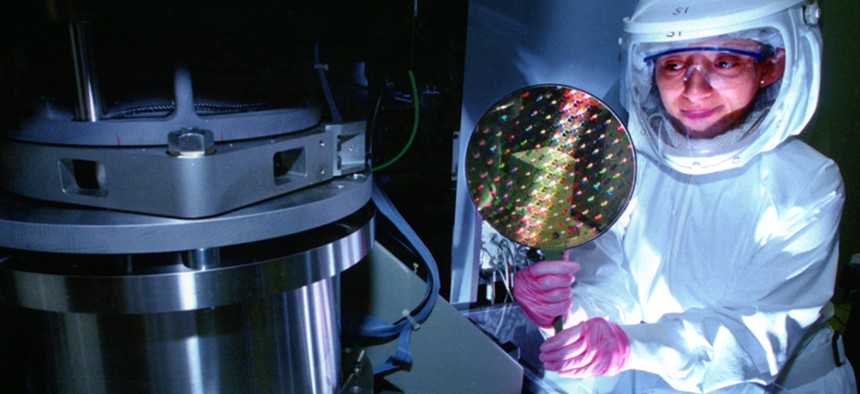
A scientist holding a radiation hardened computer chip Sandia National Laboratories
Pentagon Says Asian Spies Are Targeting Radiation-Hardened Electronics
Official review finds increased espionage in electronics that can withstand radiation events. By Rachel Oswald
The Pentagon has documented a sharp increase in military espionage from the Asia-Pacific region that focuses on specialized electronics designed to withstand radiation, such as that caused by nuclear warfare or accidents, according to an official review released last week.
For a number of years, foreign entities from East Asia and the Pacific “have demonstrated a strong interest in obtaining export-controlled U.S. rad-hard circuitry,” states the report by the Pentagon’s Defense Security Service, referring to radiation-hardened electronics.
Radiation hardening is a process by which electric components are made to withstand the effects of ionizing radiation released in a nuclear explosion, by commercial atomic reactors or the sun.
These strengthened circuits “have applications in nuclear weapons, aerospace vehicles, ballistic missiles, and other electronics used in environments subject to radiation,” the review reads.
A number of Asia-Pacific nations with growing space programs could be motivated to seek out information about radiation-resistant technology.
The fiscal 2012 DSS report did not specifically single out China as the principal culprit behind this type of spying. However, it is generally understood that Beijing is the biggest perpetrator of digital espionage in the region and is also keenly interested in improving its own strategic military capabilities.
The Chinese People’s Liberation Army is believed to be concerned about the possibility of an atomic electromagnetic pulse attack -- that is, one aimed at neutralizing its nuclear deterrent or other strategic assets that rely on electronics to operate. Additionally, China could be developing EMP weapons of its own, according to a declassified 2005 U.S. Army intelligence report.
North Korea may similarly take an interest in protecting its ballistic missiles from an EMP strike; however, the isolated nation is not believed to conduct weapons espionage to the degree that China does.
In a strike optimized for electromagnetic pulse, a nuclear warhead would be detonated far above a country. The attack could send out large amounts of radiation with the intention of confusing or simply frying the electrical systems below, including those used to run weapon systems. Some U.S. lawmakers worry about the possibility of the United States coming under this form of disruptive assault.
An alternative explanation for the intense Asia-Pacific interest is that a number of nations there with developing space capabilities likely would be interested in making sure their space-based systems are built to withstand things like solar flares and cosmic rays, according to the report. Australia, China, Japan, and South Korea all have space programs of varying size and ambitions.
The Defense Security Service, which works to limit unauthorized access to U.S. weapon system details, found that rad-hard electronics “will very likely remain highly sought after” in the future.
More broadly, the Pentagon organization has seen a major uptick in espionage efforts by Asian nations aimed at gaining backdoor knowledge of U.S. missile systems.
From fiscal 2011 to fiscal 2012, defense contractors working on U.S. missile programs self-reported an 86 percent increase in instances of attempted foreign espionage. Of these attempts, more than half came from organizations connected to the Asia-Pacific region, the Defense Security Service said.
“Foreign entities, especially those linked to countries with mature missile programs, increasingly focused collection efforts on U.S. missile technology, usually aimed at particular missile subsystems,” the report found.
Among the U.S. missile systems targeted in fiscal 2012 by intelligence collectors in this region were the submarine-launched Trident ballistic missile, the tactical Tomahawk missile, the Standard Missile 3 interceptor, the Patriot Advanced Capability 3 interceptor and the Ground Based Interceptor, according to the DSS report.
In its tracking of foreign espionage efforts, the Pentagon branch cites a number of espionage efforts under the umbrella of “collection activities.” These methods include cyber spying, attempts to acquire technology, outright requests for technical information, and foreign visits.
For the first time ever in fiscal 2012, cyber sleuthing -- termed “suspicious network activity” in the report -- was the No.1 collection method used by foreign organizations. It supplanted in rank both attempted acquisition and requests for information, which were the first and second most preferred methods, respectively, in fiscal 2011.
What is particularly troubling to the U.S. military about this change is that it has become more difficult to detect spying when it occurs; cyber espionage is harder to track than the more traditional spying methods.
“These changes meant that more direct and transparent methods were increasingly displaced by more indirect and opaque methods,” the DSS office found.


